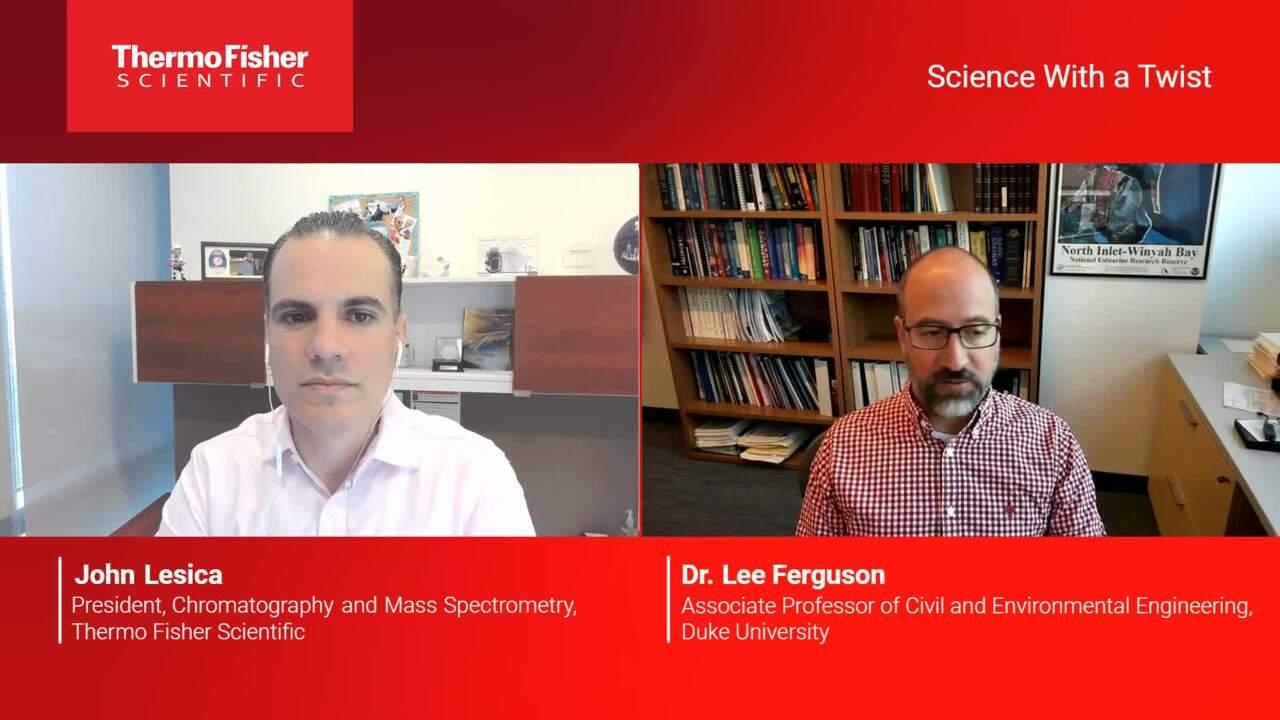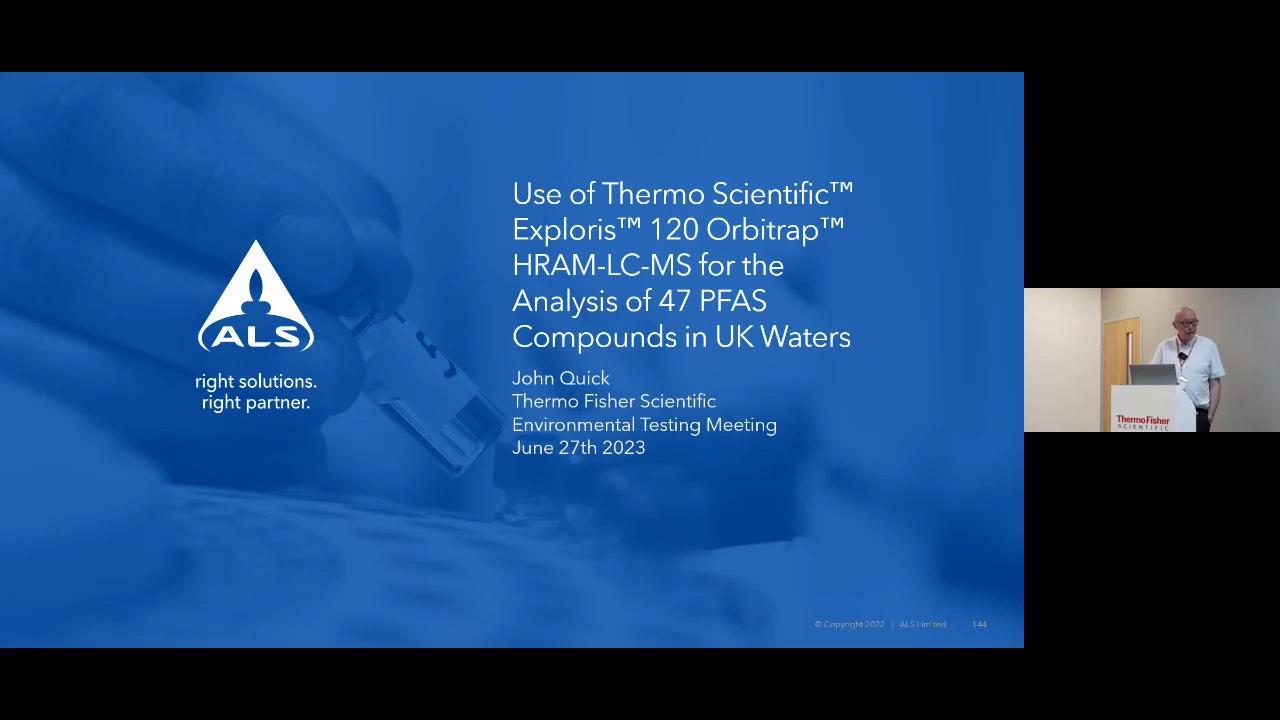Search Thermo Fisher Scientific

Complete PFAS analytical testing workflow solutions
In a rapidly evolving regulatory environment with increasing concerns surrounding PFAS (per- and polyfluoroalkyl substances) contamination, analytical testing laboratories face significant challenges in achieving accurate detection and quantification.
When it comes to PFAS testing, the future is now. Preparing your laboratory and investing in cost-effective, advanced analytical instrumentation has never been more important. We have developed validated workflows to meet your PFAS testing needs.
Enhancing Analytical Productivity
Download our latest interactive infographic to explore how your laboratory can do more with less from sample preparation to reporting for the analysis of PFAS.
By working together on your PFAS analysis, we can help you:
- Maximize testing potential with tailored PFAS workflows designed for environmental and food analytical testing labs, manufacturer QC labs, municipality/government labs, academia, and more.
- Address current regulatory requirements with a comprehensive, full-spectrum portfolio for targeted PFAS workflow solutions.
- Enable the discovery of unknown compounds in waters, solids, air or food through technologies and software for non-targeted PFAS workflows.
- Access dedicated technical support and resources as workflows continue to evolve around the growing number of PFAS found around the globe.
Maximize your business potential with workflows and instruments for PFAS testing
We have created dedicated PFAS workflow solutions, tailored to help your laboratory meet the specific needs of regional PFAS regulatory requirements. Each detailed workflow includes all aspects of technologies, from manual or automated sample extraction to chromatographic separation, detection and quantification of compounds.
Although many molecules include fluorine as part of their chemical structure, the amount of fluorine in PFAS is critical to its identification. Fluorine content can be determined as total adsorbable organic fluorine (AOF), which is measured using combustion ion chromatography (CIC). The CIC method is suitable for regulatory methods such as US EPA Draft Method 1621.
This is a highly sensitive technique that can be used to discover new or unexpected PFAS by determining whether the mass of fluorine present is greater than accounted for in a targeted list.

Validated method

Combustion ion chromatography system

Thermo Scientific Chromeleon Chromatography Data System (CDS)
Combustion ion chromatography
Software and reporting
Regulatory PFAS methods using LC- and GC-triple quadrupole mass spectrometry: For the targeted analysis of specific PFAS this powerful technique enables precise quantification and identification, even at low (ng/L) concentrations.
Targeted PFAS workflow for water – 100 µl direct injection method
Direct injection methods are based on sample dilution, filtration and acidification followed by LC-MS/MS analysis. This direct analysis method can detect 24 diverse types of PFAS compounds in a wide variety of non-drinking water matrices and used in methods such as US EPA 8327 and ASTM D7979.
ISO 21675:2019 is widely used in Europe and specifies a method for the determination of selected PFAS in non‑filtrated waters. In the EU, countries must adhere to the Drinking Water Directive (EU) 2020/2184 where 20 PFAS are regulated. Additionally, the number of target PFAS may vary by country. For example, the UK targets 47, France 7, Italy 18 and Belgium 43 PFAS.

Validated method

Thermo Scientific Vanquish Flex UHPLC System + Thermo Scientific Acclaim 120 C18 Column

Thermo Scientific TSQ Altis Plus Triple Quadrupole Mass Spectrometer

Chromeleon CDS
Chromatography and mass spectrometry analysis and detection
Software and reporting
Targeted PFAS workflow for water and solid matrices – US EPA Method 1633
Several PFAS regulatory methods require sample preconcentration and/or cleanup using solid-phase extraction (SPE) prior to LC-MS/MS analysis. The Thermo Scientific Dionex AutoTrace 280 can be used for offline automated sample preparation to increase sample throughput and reduce turnaround time when performing analysis following US EPA Method 1633 for PFAS in aqueous, solid, biosolids, and tissue samples or using similar EU methods.

Validated method

Vanquish Flex UHPLC System + Acclaim 120 C18 Column

TSQ Altis Plus Triple Quadrupole Mass Spectrometer

Chromeleon CDS
Chromatography and mass spectrometry
analysis and detection
Software and reporting
Targeted PFAS workflow for air quality
The US EPA is working to better regulate air emissions of PFAS and Other Test Method 45 (OTM-45) is a measurement of specific PFAS from stationary sources. In Europe, a research method has been developed for both neutral and ionic PFAS in ambient air using thermal desorption coupled to gas chromatography-mass spectrometry (TD-GC-MS/MS) for the analysis of 19 target PFAS.
Thermal desorption is a suitable technique for analysis of organic contaminants in air, including PFAS species. Stainless-steel thermal desorption tubes, packed with special sorbents, are used as sampling media to preconcentrate samples from hundreds of liters of air. The thermal desorption unit offers sequential and unattended analysis of up to 100 samples, eliminating the cost of liquid cryogen.

Validated method

Thermal desorption unit

Thermo Scientific TSQ 9610 Triple Quadrupole Mass Spectrometer + Thermo Scientific TRACE 1610 GC

Chromeleon CDS
Chromatography and mass spectrometry
analysis and detection
Software and reporting
On-demand webinar: Expanding the scope of PFAS screening and quantitation through targeted acquisition – water analysis and beyond
In this on-demand webinar, Dr. John Bowden, Assistant Professor at the University of Florida, Gainesville, provides an overview of the challenges non-water matrices present for extracting and quantifying PFAS, including finding blanks and validating workflows. The presentation includes a discussion of targeted PFAS quantitation using solid phase extraction (SPE) prior to LC-MS/MS analysis to perform US EPA draft method 1633.
Non-targeted workflows for PFAS testing
LC- and GC- high-resolution accurate mass spectrometry: For non-targeted analysis (NTA) of PFAS and other potential fluorine-containing compounds, using Thermo Scientific Orbitrap mass analyzer technology alongside advanced software provides comprehensive insights into PFAS contamination, ensuring regulatory compliance.
More than 40,000 known PFAS (with more PFAS being actively discovered) dictate the need for comprehensive non-targeted analysis of PFAS by high-resolution accurate mass (HRAM) mass spectrometry and turnkey software to help you characterize your samples for reporting. A wide array of automated sample preparation options is available as these workflows are not currently limited to prescriptive regulatory methodologies.

On-demand webinar: A novel approach for comprehensive profiling of 10,000+ PFAS compounds
Discover how high-resolution accurate mass (HRAM) Thermo Scientific Orbitrap technology, coupled with Thermo Scientific Compound Discoverer software, offers a powerful tool for non-targeted analysis of PFAS compounds in water and soil samples. This straightforward approach enables the detection and identification of over 10,000 PFAS compounds in a single analysis.
Featured PFAS resources
View our collection of educational, on-demand webinars to give you a deeper understanding of PFAS testing. Alternatively, watch one of our informational videos to hear how Thermo Fisher Scientific is making it easier to perform analyses of PFAS compounds in environmental samples.
PFAS workflow applications brochure
Optimal methods for PFAS testing will vary depending on the matrix you are working with and goals of your analysis. See our solutions for testing and analysis.
PFAS application note compendium
Applications include analysis of PFAS in air and food, non-targeted PFAS analysis plus discussion of chemicals and consumables for your analysis.
PFAS toolkit
Access this Toolkit to learn from application and industry experts about workflows and innovations that you can implement to advance your PFAS testing.
Technologies to meet current and future regulatory standards
Learn about the key considerations that PFAS-accredited laboratories need to make to navigate ever-changing local and regional regulations.
Semi-automated clean up of soil samples
Learn more about LC-MS/MS analysis of per- and polyfluoroalkyl substances (PFAS) in soil samples in accordance with EPA Draft Method 1633.
Analysis of 54 PFAS compounds in drinking water
Achieve high-level sensitivity when performing direct injection analysis of 54 PFAS compounds in the low ng/L range in drinking water.
Screening of PFAS compounds in wastewater
Multilab collaboration study using CIC to determine adsorbable organic fluorine as per EPA Method 1621
We can help you meet your PFAS analytical challenges. Contact us.
* Required field












